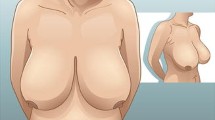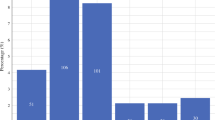Abstract
Background
Age, pregnancy and weight change can affect the shape of the female breast. Various mastopexy/augmentation techniques have been described to address these changes which work well in primary and uncomplicated cases. However, there is a distinctive category of high-risk patients which includes post-bariatric, active smokers, those with poor skin quality, wanting larger implants or undergoing secondary surgery. The complications reported in this group of patients are as high as 32%.
Materials and Methods
We describe a new technique of one-stage mastopexy/augmentation, using a wide dermo-glandular pedicle, and our early results with 51 consecutive patients.
Results
Fifty-one patients were operated between January 2016 and September 2018, with a mean age of 40.0 years. Ten patients were smokers, eight were post-massive weight loss, six had previous mastopexy. At a mean follow-up of 22 months, only two patients had a unilateral bottoming out. There were no incidents of hematoma, seroma, capsular contracture or major tissue-related complications.
Conclusion
Plastic surgery has been described as a struggle between beauty and blood supply. We have performed a one-stage mastopexy/augmentation using a wide and thick dermo-glandular glandular pedicle to maximize the blood supply in a range of challenging patients with promising results.
Level of Evidence IV
This journal requires that authors assign a level of evidence to each article. For a full description of these Evidence-Based Medicine ratings, please refer to the Table of Contents or the online Instructions to Authors www.springer.com/00266.







Similar content being viewed by others
References
Tessone A, Millet E, Weissman O et al (2011) Evading a surgical pitfall: mastopexy–augmentation made simple. Aesthetic Plast Surg 35:1073–1078
Gonzalez-Ulloa M (1960) Correction of hypotrophy of the breast by means of exogenous material. Plast Reconstr Surg Transplant Bull 25:15–26
Regnault P (1966) The hypoplastic and ptotic breast: a combined operation with prosthetic augmentation. Plast Reconstr Surg 37(1):31–37
Khavanin N, Jordan SW, Rambachan A, Kim JY (2014) A systematic review of single-stage augmentation mastopexy. Plast Reconstr Surg 134(5):922–931
Stevens WG, Macias LH, Spring M, Stoker DA, Chacón CO, Eberlin SA (2014) One-stage augmentation mastopexy: a review of 1192 simultaneous breast augmentation and mastopexy procedures in 615 consecutive patients. Aesthet Surg J 34:723–732
Swanson E (2016) All seasons vertical augmentation mastopexy: a simple algorithm, clinical experience, and patient-reported outcomes. Plast Reconstr Surg Glob Open 4:e1170
Montemurro P, Cheema M, Hedén P, Behr B, Wallner C (2019) Benchmarking the outcomes of single-stage augmentation mastopexy against primary breast augmentation: a single surgeon's experience of 905 consecutive cases. Plast Reconstr Surg 144(2):326–334
Spear SL, Low M, Ducic I (2003) Revision augmentation mastopexy: Indications, operations, and outcomes. Ann Plast Surg 51:540–546
Montemurro P, Agko M, Quattrini Li A, Avvedimento S, Hedén P (2017) Implementation of an integrated biodimensional method of breast augmentation with anatomic, highly cohesive silicone gel implants: short-term results with the first 620 consecutive cases. Aesthet Surg J 37(7):782–792
Montemurro P, Avvedimento S, Hedén P, Quattrini LA (2016) A four-layer wound closure technique with barbed sutures for stable reset of the inframammary fold in breast augmentation. Aesthet Surg J 36(8):966–971
Taylor GI, Corlett RJ, Dhar SC, Ashton MW (2011) The anatomical (angiosome) and clinical territories of cutaneous perforating arteries: development of the concept and designing safe flaps. Plast Reconstr Surg. 127:1447–1459
Hall-Findlay EJ (2002) Pedicles in vertical breast reduction and mastopexy. Clin Plast Surg 29:379–391
Hamdi M, Hall-Findlay EJ (2005) Pedicle choices in breast reduction. In: Hamdi M, Hammond D, Nahai F (eds) Vertical scar mammaplasty. Springer, Berlin, pp 11–15
van Deventer PV, Graewe FR (2016) The blood supply of the breast revisited. Plast Reconstr Surg 137(5):1388–1397
Hall-Findlay EJ, Shestak KC (2015) Breast reduction. Plast Reconstr Surg 136(4):531e–e544
le Roux CM, Pan WR, Matousek SA, Ashton MW (2011) Preventing venous congestion of the nipple-areola complex: an anatomical guide to preserving essential venous drainage networks. Plast Reconstr Surg 127(3):1073–1079
Hall-Findlay EJ (1999) A simplified vertical reduction mammaplasty:shortening the learning curve. Plast Reconstr Surg 104(3):748–759
Finger RE, Vasquez B, Drew SG, Given KS, Hauben DJ (1989) Superomedial pedicle technique of reduction mammaplasty. Plast Reconstr Surg 83(3):479–480
Antony AK, Yegiyants SS, Danielson KK et al (2013) A matched cohort study of superomedial pedicle vertical scar breast reduction (100 breasts) and traditional inferior pedicle wise-pattern reduction (100 breasts). Plast Reconstr Surg 132(5):1068–1076
Kemaloglu CA, Özocak H (2018) Comparative outcomes of inferior pedicle and superomedial pedicle technique with wise pattern reduction in gigantomastic patients. Ann Plast Surg 80(3):217–222
Hidalgo DA, Spector JA (2013) Mastopexy. Plast Reconstr Surg 132(4):642e–656e
Spring MA, Hartmann EC, Stevens WG (2015) Strategies and challenges in simultaneous augmentation mastopexy. Clin Plast Surg 42(4):505–518
Beale EW, Ramanadham S, Harrison B et al (2014) Achieving predictability in augmentation mastopexy. Plast Reconstr Surg 133(3):284e–292e
Lee MR, Unger JG, Adams WP Jr (2014) The tissue-based triad: a process approach to augmentation mastopexy. Plast Reconstr Surg 134(2):215–225
Sanniec K, Adams WP (2019) The tissue-based triad in augmentation mastopexy: single-stage technical refinements. Aesthetic Surg J 39(12):1331–1341
Kalaaji A et al (2018) Quality of life after breast enlargement with implants versus augmentation mastopexy: a comparative study. Aesthetic Surg J 38(12):1304–1315
Spear SL, Pelletiere CV, Menon N (2004) One-stage augmentation combined with mastopexy: aesthetic results and patient satisfaction. Aesthetic Plast Surg 28:259–267
Persoff MM (2003) Mastopexy with expansion-augmentation. Aesthet Surg J 23:34–39
Gallent IM, Pons MR, Drever M (2003) Vertical scar mastopexy with an implant. Aesthetic Plast Surg 27:406–410
Karnes J, Morrison W, Salisbury M, Schaeferle M, Beckham P, Ersek RA (2000) Simultaneous breast augmentation and lift. Aesthetic Plast Surg 24:148–154
Swanson E (2013) Prospective comparative clinical evaluation of 784 consecutive cases of breast augmentation and vertical mammaplasty, performed individually and in combination. Plast Reconstr Surg 132(1):30e–45e
Hickman DM (2011) Application of the Goes double-skin peri-areolar mastopexy with and without implants: a 14-year experience. J Plast Reconstr Aesthet Surg 64:164–173
Nahai F, Fisher J, Maxwell PG, Mills DC II (2007) Augmentation mastopexy: to stage or not. Aesthet Surg J 27:297–305
Gonzalez R (2012) The PAM method—periareolar augmentation mastopexy: a personal approach to treat hypoplastic breast with moderate ptosis. Aesthet Surg J 32:175–185
Ikander P, Gad D, Gunnarsson GL et al (2017) Simple reshaping of the breast in massive weight loss patients. Ann Plast Surg 78:145–148
Cannon CL III, Lindsey JT (2010) Conservative augmentation with periareolar mastopexy reduces complications and treats a variety of breast types: a 5-year retrospective review of 100 consecutive patients. Ann Plast Surg 64:516–521
Manero I, Rodriguez-Vega A, Labanca T (2019) Combined breast reduction augmentation. Aesthetic Plast Surg 43(3):571–581. https://doi.org/10.1007/s00266-019-01318-4 (Epub 2019)
Chasan P (2018) Reductive augmentation of the breast. Aesthetic Plast Surg 42(3):662–671
Spring MA, Macias LH, Nadeau M, Stevens WG (2014) Secondary augmentation-mastopexy: indications, preferred practices, and the treatment of complications. Aesthet Surg J 34:1018–1040
Somogyi RB, Stavrou D, Southwick G (2015) Correction of small volume breast asymmetry using deep parenchymal resection and identical silicone implants: an early experience. Aesthet Surg J 35(4):394–401
Funding
The authors received no financial support for the research, authorship and publication of this article.
Author information
Authors and Affiliations
Corresponding author
Ethics declarations
Conflict of interest
Dr. Montemurro, Dr. Cheema and Dr. Pellegatta report no disclosures and no potential conflicts of interest with respect to the research, authorship and publication of this article. Dr. Hedén is a consultant and speaker for Allergan, Inc., Establishment Labs Co, G&G Medical, GC Aesthetics, Johnsson & Johnsson (Irvine, Calif.) and an unpaid consultant for Canfield Scientific (Fairfield, N.J.). The Declaration of Helsinki guidelines were followed, and written informed consent was obtained in all cases.
Additional information
Publisher's Note
Springer Nature remains neutral with regard to jurisdictional claims in published maps and institutional affiliations.
Supplementary Information
Below is the link to the electronic supplementary material.
Supplementary file 1 (MP4 163 MB)
Rights and permissions
About this article
Cite this article
Montemurro, P., Cheema, M., Hedén, P. et al. The Dual Vascular Pedicle: A Novel Method to Approach Challenging Cases in Single-Stage Mastopexy/Augmentation. Aesth Plast Surg 45, 921–930 (2021). https://doi.org/10.1007/s00266-020-02109-y
Received:
Accepted:
Published:
Issue Date:
DOI: https://doi.org/10.1007/s00266-020-02109-y




